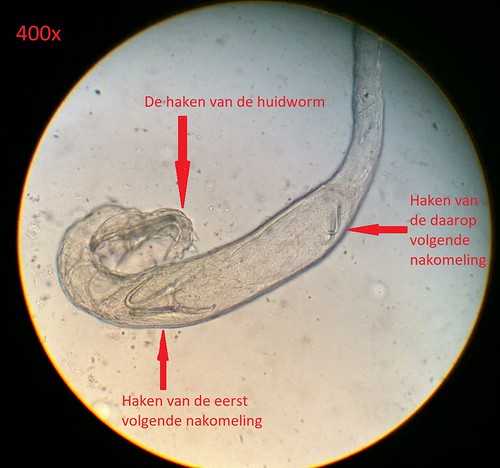Skin Worm (Gyrodactylus)
This parasite occurs very regularly. Of all the parasites that are not visible to the naked eye, the skin worm is the largest parasite, which you have to look at with a microscope. Once in focus, you can hardly miss it. The 40x magnification is big enough. Actually, you could also say: A skin worm is just too small to see with the naked eye. Despite its size, I am least afraid of this parasite. A skin worm is multicellular and cannot multiply by cell division. The skin worm is viviparous, so new skin worms are born. This process takes a few days and is temperature-dependent.

With its head it eats organic material, including small amounts of mucous membrane. On the other side are two hooks with which he holds on to the Koi. These hooks are irritating and can damage the Koi.
The skin worm is a worm and falls under the category of trematode. This means that they don’t look like an earthworm or tapeworm.
Danger
The danger of the skin worm lies in two things.
For example, the skin worm is very similar to the gill fluke, which can cause more damage because it targets the delicate tissue in the gills of the fish.
(The gill fluke will be added later in this series of ‘parasites’)
Treatment is done by means of an anti-worm medicine. These products are widely used in livestock farming and veterinary practices (deworming dogs, cats, pigs, chickens) and due to frequent use, resistance increases rapidly.
Hobbyists tend to use a product that works well next time, while it may be wise to switch the product and the active ingredient next time. Some active substances against worms are: praziquantel, flubendazole, triclamdazole.
Only use such a pesticide if the situation really requires it. A single skin worm can solve a healthy Koi just fine.
Name: Skin worm (Gyrodactylus)
Type: Worm-like, trematode
Multiplication: LivebearingSize
: 0.5 mm (=500 micron)
Magnification microscope: 40x is sufficient
Cause of outbreak: Poor water quality, stress, contamination
Symptoms: abnormal behavior such as fin pinching, jumping, chafing, not eating, seclusion, lethargy.



